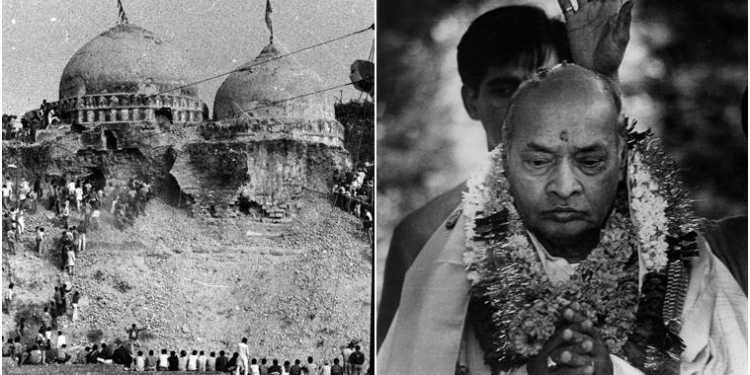Former Prime Minister P V Narasimha Rao’s role in Babri Masjid continues to be debated even 24 years after the disputed structure by the name of Babri Masjid was brought down. Some have described Narasimha Rao as the first BJP Prime Minister, others as a gullible lamb led to the slaughterhouse by the BJP, others define Rao as having a pro-Hindu mindset, still others as someone who acted too little, too late.
Narasimha Rao’s role in the whole demolition case is complex and the existence of multiple perspectives, shaped mostly by political viewpoints has made it literally impossible to understand his role. The fact of the matter is that India in the early 90s was surrounded by several seemingly insurmountable challenges.
For the first time, it seemed that the country’s existence was imperiled. Jammu and Kashmir was burning with separatism, Punjab was reeling under an endless insurgency, Tamil Nadu was up in flames thanks to the Tamil Eelam issue and Assam was struggling to contain a resurgent ULFA militancy. The country had recently lost a former Prime Minister to an assassin and to top it all, the finances of the nation had gone awry. Amidst all this, BJP had hitched its wagon to the Ram Janmabhoomi issue. The Northern states were gripped with excitement. To be fair to Narasimha Rao, he did not create any of these crises.
In fact, the blame for almost all of the crises that Narasimha Rao had to grapple with, goes solely to the Gandhi regimes that had come to power before him. In fact, Congress was all set to lose the elections held in ’91 had it not been for Rajiv Gandhi’s assassination that spurred a last minute change in voting powers that brought a Congress minority government under Rao, who incidentally, was all set to retire from political life. In that sense, Rao was India’s first accidental Prime Minister.
It was the Rajiv Gandhi government that had unlocked the gates of the disputed structure way back in 1986, to appease the Hindu votes. Soon thereafter, the low-key Ram Janmabhoomi movement acquired a life of its own. Slogans of ‘Mandir wahin banayenge‘ began to reverberate in towns and cities in the country. At the time when Narasimha Rao took the reins of power, the Ram Janmabhoomi Aandolan had been able to resonate emotionally with the masses.
Wasting no time, Rao began deliberations with leaders of the BJP and other groups who were pushing for the construction of a temple in Ayodhya. Unlike many other Congress leaders, Rao was a Hindu-secularist. He was visibly miffed with the BJP for trying to appropriate Ram. In fact, he once pointedly asked, ‘Does the BJP own Ram, whom all Hindus worship?”. He also said that the Congress was a secular party, but that didn’t mean that Congressmen were atheists. It was statements like these that led Mani Shankar Aiyer to blame the destruction of the disputed Babri Masjid structure to ‘Rao’s pro-Hindu mindset’. In fact, Aiyer claims that Rao told him that he did not agree with Aiyer’s definition of Secularism as India is a Hindu-majority country.
Given his conviction as a Hindu, Narasimha Rao urgently began a dialogue process with Hindu and Muslim groups, even mediating in the discussions between Hindus and Muslims. In all of his meetings, Rao would quote sanskrit texts to press Hindu groups for an assurance that the disputed structure be unharmed. He was convinced of his negotiating skills and his powers of influence over others, given his knowledge of scripture and texts. Perhaps, it was this blind trust that he placed in others that eventually let him down.
At the same time, Rao engaged with BJP leaders, Advani and Vajpayee who repeatedly assured him that the disputed structure could stay. A wily politician himself, Narasimha Rao, also sought to loop in Supreme Court to see if the Central government could take control over disputed land, but the Supreme Court chose to believe Kalyan Singh when he swore to protect the disputed structure. At the same time, Rao asked his officials to come up with contingency plans to take control over the site by force if the need arose.
Sadly, events outpaced Narasimha Rao. Those he trusted chose to act in their best interests. Rao’s folly in the demolition of the disputed Babri Masjid structure was not in his intent, but in his miscalculations.
Rao’s decision to sit and discuss instead of act and execute, emboldened mischievous elements. On 6th December, a day which could have been tense and worrisome like the days preceding it, all hell broke loose on the disputed site. TV cameras showed images of mobs descending on the disputed structure and razing it to the ground. BJP leaders would later claim that they were powerless to control the mobs. There are multiple reports of Rao going into shock at the turn of events. He could not believe that the people he had trusted had stabbed him in his back.
While there are multiple perspectives on what Narasimha Rao could have done and done better, one forgets the ground realities of the time. Rao was in a precarious position as the leader of a minority government. Had he dismissed the Kalyan Singh led BJP government in UP, BJP would have brought in a motion of no confidence against the government and precipitated a political crisis in the country. Not only that, the Supreme Court would have hauled Rao over the coals for dismissing an elected government without any reason. Also, didn’t the Supreme Court itself choose to trust Kalyan Singh when he swore that the disputed structure wouldn’t be harmed.
Hindsight, though advantageous, often blurs the ground reality of the day. Rao was more a victim of those times than its perpetrator.
References:
http://www.theweek.in/news/india/narasimhaa-rao-pro-hindu-mindset-led-to-babrii-demolitio-aiyar.html


































